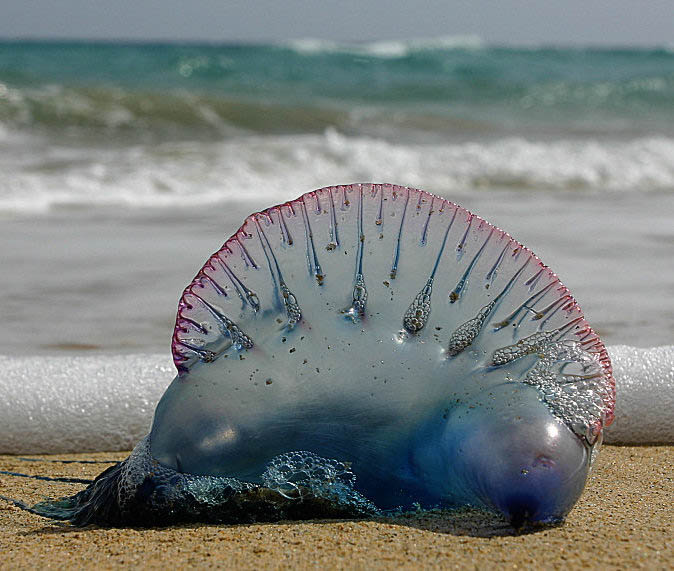
Please exercise caution.
If you’re planning a summer get-a-away trip to Lawrencetown Beach, Nova Scotia, in the coming days, be aware that a Portuguese Man O War has washed up on the beach. It has been said that finding a single Portuguese Man O War can be followed by finding many others in the vicinity.
The Portuguese Man O War is not indigenous to Nova Scotia or Canada. It’s a hard to come by in Atlantic Canada. Man O War tentacles average about 30 feet long but can grow to be 165 feet long. The stinging, venom-filled nematocysts in the Portuguese Man O War tentacles can paralyze small fish and other prey. Winds can cause them to drift into bays or onto beaches. Beachgoers are well aware of the painful stings delivered by their tentacles. Because they can sting while beached, finding one washed up on a beach may result in the beach being closed. Detached tentacles and dead specimens (including those washed up on shore) can sting just as painfully as the live organism in the water, and can last for hours or even days after the organism’s death or tentacle detachment.
The Portuguese Man O War is a prominent member of the neuston, a community of organisms living on the ocean’s surface. It has numerous venomous microscopic nematocysts that deliver a painful sting strong enough to kill fish and has been known to kill humans on occasion. Although it appears to be a jellyfish, the Portuguese Man O War is actually a siphonophore. It, like all siphonophores, is a colonial organism composed of many smaller units known as zooids. All zooids in a colony are genetically identical, but perform specialized functions like feeding and reproduction, allowing the colony to function as a single individual.
The Portuguese Man O War lives at the ocean’s surface and is found mostly in tropical and subtropical waters. The gas-filled bladder, or pneumatophore, remains visible on the surface, while the rest of the body is submerged.
The Portuguese Man O War eats meat. It paralyses its prey with its venomous tentacles before “reeling” it inwards to the digestive polyps. It eats small adult fish and young fish, as well as zooplankton, shrimp, and other small crustaceans.
The organism has few predators of its own; one in particular is the loggerhead turtle, which consumes Portuguese Man O War as part of its diet on a regular basis. The stings cannot penetrate the turtle’s skin, including that of its tongue and throat.
Lawrencetown Beach
Lawrencetown Beach is a provincial beach park on the Eastern Shore of Nova Scotia, 19 kilometres (12 miles) east of Dartmouth on Route 207.
Lawrencetown Beach is well-known for its surf and is popular among local and visiting surfers. Surfing lessons and outfitters are available near the park. Swimming is supervised (July – August). Swimmers must exercise caution because rip tides and currents are common. Provincial and regionally significant coastal park system; includes regionally significant beach parks, proximity to rails-to-trails corridor, Trans Canada Trail runs through Cole Harbour Heritage Park.






